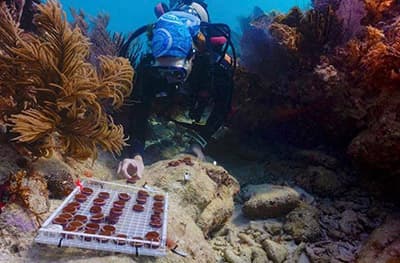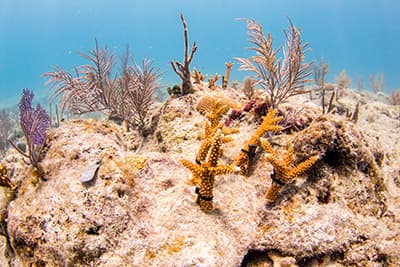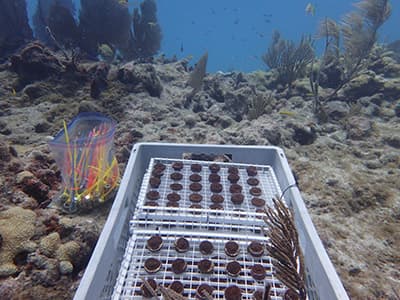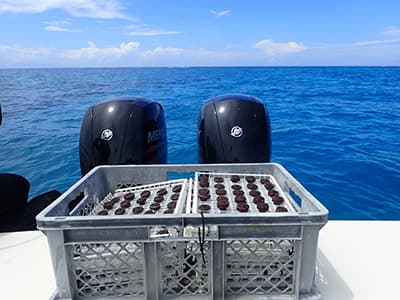Mission: Iconic Reefs
NOAA and partners have launched an unprecedented effort to restore seven ecologically and culturally significant coral reefs within Florida Keys National Marine Sanctuary. Informed by years of research, successful trials, and expertise, the mission represents one of the largest investments ever undertaken in coral restoration. By focusing additional efforts on coral reef habitat, Mission: Iconic Reefs complements NOAA's ongoing Florida Keys National Marine Sanctuary Restoration Blueprint and management plan.
The effort to put Florida Keys coral reefs on track for recovery is an enormous undertaking, requiring long-term collaboration between many partners. A cross-NOAA team is engaging world-renowned scientists, local restoration partners, and other federal and state agencies to save these important, iconic resources.
Using the best available restoration science, we will restore diverse, reef-building corals at seven reef sites within Florida Keys National Marine Sanctuary:
- Carysfort Reef. (PDF, 2 pages)
- Horseshoe Reef. (PDF, 2 pages)
- Cheeca Rocks. (PDF, 2 pages)
- Newfound Harbor. (PDF, 2 pages)
- Eastern Dry Rocks. (PDF, 2 pages)
- Sombrero Reef. (PDF, 2 pages)
- Looe Key Reef. (PDF, 2 pages)
These sites represent the iconic diversity and productivity of Florida Keys coral reefs. They span the geographic extent of the region, a variety of habitats, and a range of human uses. They also have a history of restoration success, or have characteristics that indicate restoration is likely to succeed.
Eastern Dry Rocks
NOAA and partners have begun a three-year effort to outplant more than 60,000 fragments of nursery-raised coral at Eastern Dry Rocks Sanctuary Preservation Area off Key West. This is the first large-scale endeavor dedicated to Mission: Iconic Reefs, the unprecedented effort to restore seven coral reefs within Florida Keys National Marine Sanctuary.
Eastern Dry Rocks contains a concentration of bank reef habitats that are ecologically and economically important to the Florida Keys. The elkhorn and staghorn corals that are being transplanted in more than nine acres there include a high number of distinct genetic strains representing the historical diversity found on these reefs, and genotypes that have exhibited the highest survival and growth rates. Practitioner partners that will assist in the outplanting grew the corals in their respective nurseries over six to eight months.
Coral Outplanting
Mote Marine Laboratory grows coral fragments on plug-shaped ceramic pieces. When it’s time to restore these fragments to the reef, the team underwater drills a small hole into the old coral head and then attaches the plug with the coral fragment into the hole. The same species and genotype of the coral is restored near each other. Eventually, the coral fragments will grow over the whole plug, and touch each other. Since they are the same genotype, they’ll fuse, and essentially an old coral head is "reskinned" by this process, speeding up the natural growth process.
Credit: Mote Marine Laboratory

Mote Marine Laboratory staff biologist Sarah Hamlyn places elkhorn coral fragments onto an old coral head as part of a coral restoration project in Key Biscayne.
Credit: Sarah Hamlyn/Mote Marine Laboratory

Mote Marine Laboratory places coral fragments onto the reef typically in arrays of five. For branching corals such as these staghorns, as the corals grow, they'll turn into much larger "thickets" in just a couple of years.
Credit: Conor Goulding/Mote Marine Laboratory

Mote Marine Laboratory grows elkhorn coral fragments on ceramic plugs on land before they are taken out to be placed onto the reef. The fragments eventually completely grow over their plug.
Credit: Mote Marine Laboratory

Up to 600 coral fragments can be restored to degraded reefs each day by Mote Marine Laboratory's coral restoration team. Thousands more fragments are growing in Mote's land-based and underwater nurseries.
Credit: Mote Marine Laboratory
B-roll videos
Examples of stony coral tissue loss disease affecting star coral, maze coral, and pillar coral in Florida Keys National Marine Sanctuary. Scientists observe and record disease progression on a large pillar coral colony.
Credit: Nick Zachar/NOAA
Divers visit a coral nursery and help clean staghorn and elkhorn coral "tree" structures to remove nuisance algae. Nursery-grown corals are transported to the reef for outplanting. To outplant corals, divers prepare the substrate by removing surface sediment and algae, then affix coral colonies to the reef using marine epoxy. After outplanting, coral fragments grow into mature colonies, contributing to the structure and diversity of Florida Keys National Marine Sanctuary reefs.
Credit: Nick Zachar/NOAA, Paul Chetirkin/NOAA, Coral Restoration Foundation
Restoration practitioners glue tiny "microfragments" of coral onto ceramic plugs in a land-based nursery. Using this strategy, slow-growing coral species can grow relatively quickly, and can fuse together to form large colonies.
Credit: Nick Zachar/NOAA
Healthy coral reefs create impressive structures that are home to a vibrant array of fish and other reef creatures, support dive and snorkel tourism, and protect Florida Keys shorelines.
Credit: Nick Zachar/NOAA, David Ruck/NOAA
Maps and stills

Mission: Iconic Reefs - Overview Document

A diver prepares a site for staghorn coral replanting by removing nuisance algae.
Credit: Coral Restoration Foundation

An ocean-based coral nursery operated by the Coral Restoration Foundation in Florida Keys National Marine Sanctuary. Species like staghorn coral (pictured) are grown in these nurseries and transplanted to reefs.
Credit: Coral Restoration Foundation

A diver replanting staghorn coral. The coral fragments are attached to the reef with epoxy and tagged to keep track of genetic information.
Credit: Coral Restoration Foundation

A map showing the location of the seven iconic reef sites proposed as focal areas for large-scale restoration.
Credit: NOAA

This simple map outlines the boundaries of Florida Keys National Marine Sanctuary in relation to south Florida. It does not show the boundaries of individual marine zones, or the boundaries of other state or federal areas.
Credit: NOAA

Two-year-old elkhorn coral colonies transplanted to Carysfort Reef by the Coral Restoration Foundation.
Credit: A. Neufeld/Coral Restoration Foundation

A diver cleans algae and other nuisance species from coral "tree" structures in a Coral Restoration Foundation nursery. These structures are used to grow staghorn coral (pictured) and other coral species in ocean-based nurseries.
Credit: A. Neufeld/Coral Restoration Foundation

Two divers work together to replant staghorn coral to a reef using epoxy. Marine epoxy is a frequently-used method for adhering nursery-grown corals to reefs.
Credit: A. Neufeld/Coral Restoration Foundation

Fragments of elkhorn coral wait to be attached to the reef at Looe Key. Zoanthids, a type of marine invertebrate that can compete with corals for space, cover much of the surrounding reef area.
Credit: A. Neufeld/Coral Restoration Foundation

Elkhorn coral transplanted to Carysfort Reef by the Coral Restoration Foundation in 2017 (left), and the same colonies in 2019, after two years of growth (right). Elkhorn coral is a fast-growing species that creates important, three-dimensional structure on Florida reefs.
Credit: A. Neufeld/Coral Restoration Foundation

Corals grown in a land-based nursery await transplanting. These corals were produced by sexual reproduction (from coral eggs and sperm). This method can help to increase genetic diversity in restored populations.
Credit: The Florida Aquarium

Staghorn corals grown in a land-based nursery are transported for replanting. Land-based nurseries are important tools for restoration.
Credit: The Florida Aquarium
-colony-at-sombrero_ken-nedimyer-400.jpg)
Dead Elkhorn coral (Acropora palmata) at Sombrero Reef. (shows the need for restoration)
Credit: Ken Nedimyer

A thicket of elkhorn coral, most of it dead, at Looe Key Reef. (shows the need for restoration)
Credit: Ken Nedimyer

Mote Marine Laboratory on Summerland Key developed a micro-fragmentation and fusion method to speed the growth of crucial reef-building species.
Credit: Mote Marine Laboratory and Aquarium

One of the seven iconic reef sites, Cheeca Rocks, is dominated by large populations of star corals and other boulder corals
Credit: FKNMS/NOAA

